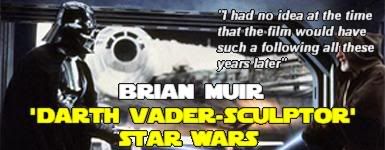Below is the interview I had with him. Happy reading!

Can you tell us how you got involved with Star Wars: A New Hope?
I had been out of the film industry for over three years when I received a phone call from Arthur Healey, the sculptor who I trained under at Elstree Studios, to start on a Sci-Fi film. Initially I was told it was six weeks work and took the risk of leaving a secure job to be back to work I loved. Little did I know of it's significance!
You had the task to sculpt the best known, most popular villian in the history of movies: Darth Vader. Can you tell something about this process?
The plasterers moulded Dave Prowse to create a plaster cast of his head and body. Having cut the head and shoulders from the rest of the body, to make it easier to handle, I used this to start the sculpting process for the now iconic Vader mask. There had to be at least 1/4 inch of clay on the head at any point to allow for casting thickness and to know that it would fit on Dave’s head.
Once I had sculpted the mask to a finish, which was originally designed to have a front and rear section, it was handed to the plasterers to mould and cast in plaster.
I then applied clay to the plaster Vader mask and sculpted the helmet.

People like Ralph McQuarrie and John Mollo did some designs for him and then it was up to you. Did you have the chance to put little changes in it so that Darth Vader would have something typically Brian Muir in it?
With any sculpt taken from a two-dimensional drawing there is always an input from the sculptor. Every sculptor works in different ways and has their own interpretations of a design. I can always tell my own work.
In both the Empire Strikes Back and Return of the Jedi they slightly changed Vader's helmet. Do you know why they did that? In my opinion there was no need to change the sculpt.
I don’t know whether it was George Lucas or designer Norman Reynolds or a combination of the two or why it was decided to make the changes. I agree there was no need to change or remove the widow’s peak as in my opinion it added to Vader’s menacing character.

(photo © Brian Muir)
Besides Darth Vader, you also worked on C-3PO, the Death Star Droid and CZ-3. What did you exactly do for these three droids?
Liz Moore was the main sculptor on C-3P0 – when she left the film I was responsible for sharpening the suit and helmet at the plaster stage adding a few minor changes to the detail.
For the Death Star Droid and CZ-3 I sculpted the heads and the bodies were made from pieces used for C-3PO. The chest piece for CZ-3 was sculpted by Arthur Healey.
I just thought I should mention that I also sculpted the Stormtrooper armour, which has proven to be very topical in recent years. Liz Moore sculpted the helmet.

Actor Anthony Daniels played both C-3PO and CZ-3. He told me in our interview that the C-3PO's suit made him claustrofobic at first and the 'pins' in his neck hurt. Did you had to keep such a thing in mind when you created the suit?
I don’t doubt the suit was claustrophobic, as it was totally enclosed, particularly in the heat of the Tunisian desert. At least Dave Prowse was fortunate enough to have the back of Vader’s mask discarded as it was covered by the helmet.
Did you get any response from George Lucas and/or Gary Kurtz? If so, what did they have to say?
Gary Kurtz came into the sculptor’s studio and took photographs on several occasions but he made no comment on the sculpting.
Although he seems to be mentioned very rarely, it was the designer John Barry who mentioned the addition of the ‘tear ducts’ and the lengthening of the tubes at the clay stage.
George Lucas came into my studio a few times to look at the progression of the sculpt and seemed happy with it. When John Barry felt that the creation of Vader’s mask and helmet were complete, he then called George Lucas in to give his final approval. Although I do not remember his actual words I do remember him being very pleased with the sculpt and made no changes.
What is your personal opinion about Star Wars?
When I finally saw the film on screen, I was amazed. It was very difficult to visualize at that time what could be achieved with the ground - breaking techniques that were developed for Star Wars. Even watching the films today, when movie technology has moved on so far, they still stand the test of time. The simple basis of the story of Good against Evil is timeless.
Besides Star Wars, you have worked on two other big Lucasfilm productions: Raiders of the Lost Ark and Indiana Jones and the Temple of Doom.
Can you tell us something what you did for these two movies, and what your experiences were while working on them?
On Raiders of the Lost Ark some of the work I sculpted was the cobra, ornamental detail on the Ark of the Covenant and the rock set for the Nazi’s secret island.
Indiana Jones and the Temple of Doom involved a vast amount of sculptural work. I was fortunate enough to have been given some prominent pieces including :- the python, gong, baby elephant’s head, two horse panels etc.
I give details of my experiences of working on these films in my recently published autobiography ‘In the Shadow of Vader’

You worked on a dozen of my all-time favorite movies including the Dark Crystal. Can you share some of your experiences regarding that movie? What did you do for instance? And how was it to work with Frank Oz and the legendary Jim Henson?
The Dark Crystal is also a favourite of mine – a very unique movie for its time. I sculpted the rock stacks, the standing stones and walkway in the Mystic Valley.
There were also many elements of the sets that had to be carved in polystyrene in situ.
I did not work with Frank Oz or Jim Henson as their main involvement was with the puppetry aspects of the film. Harry Lange was the designer and I worked directly with him.
You have recently released your autobiography. Can you give some more information like what we can expect in the book and how it can be ordered?
Yes I mentioned previously I have recently had my autobiography published titled ‘In the Shadow of Vader’.
To quote the back cover ‘ An amazing insight into the life and career of Brian Muir who famously sculpted the iconic Darth Vader at the young age of 23.
With over 40 years experience working on over 60 major films, Muir gives us a window into the mysterious world ‘behind the scenes’.
His life’s work reveals his unseen talent that is ‘In the Shadow of Vader’
The book can either be ordered from me by emailing me on:- vadersculptor@googlemail.com or through Amazon.co.uk or Amazon.com.

Looking back at your career so far, what do you see as your biggest achievement?
Having been lucky enough to have such a varied and fulfilling career it is difficult to pick out one individual achievement. I am very proud to have had work unveiled by the Queen, Queen Mother and to have been privileged to have Prince Charles visit my workshop and show genuine interest in my work.
Although the work over the years has been challenging at times, it becomes second nature with experience. Something that I had talked about for years that I did not think would come to fruition was writing my autobiography. I feel this has been one of my biggest achievements and in some ways is my legacy to my family and the Star Wars and film fans. It gives me great pleasure to think that some time in the future my young grandson and future grandchildren will be able to read the book and know about their grandfather’s life and career.
You were a part of the crew that made Star Wars, the most popular movie ever. How do you look back at Star Wars?
I have fond memories of being part of the Star Wars production. From working with Liz Moore, John Barry, George Lucas and of course the plasterers it was an enjoyable experience. I had no idea at the time that the film would have such a following all these years later. It was my step back into the film industry for which I will be forever grateful. I am happy to be acknowledged as the sculptor of the iconic Darth Vader and all that has involved in recent years.
